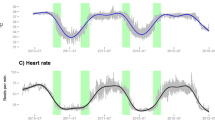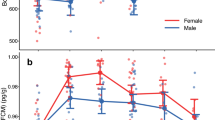Abstract
Precise measures of phenology are critical to understanding how animals organize their annual cycles and how individuals and populations respond to climate-induced changes in physical and ecological stressors. We show that patterns of core body temperature (T b) can be used to precisely determine the timing of key seasonal events including hibernation, mating and parturition, and immergence and emergence from the hibernacula in free-living arctic ground squirrels (Urocitellus parryii). Using temperature loggers that recorded T b every 20 min for up to 18 months, we monitored core T b from three females that subsequently gave birth in captivity and from 66 female and 57 male ground squirrels free-living in the northern foothills of the Brooks Range Alaska. In addition, dates of emergence from hibernation were visually confirmed for four free-living male squirrels. Average T b in captive females decreased by 0.5–1.0°C during gestation and abruptly increased by 1–1.5°C on the day of parturition. In free-living females, similar shifts in T b were observed in 78% (n = 9) of yearlings and 94% (n = 31) of adults; females without the shift are assumed not to have given birth. Three of four ground squirrels for which dates of emergence from hibernation were visually confirmed did not exhibit obvious diurnal rhythms in T b until they first emerged onto the surface when T b patterns became diurnal. In free-living males undergoing reproductive maturation, this pre-emergence euthermic interval averaged 20.4 days (n = 56). T b-loggers represent a cost-effective and logistically feasible method to precisely investigate the phenology of reproduction and hibernation in ground squirrels.




Similar content being viewed by others
References
Akaike H (1973) Information theory and an extension of the maximum likelihood principle. In: Petrov BN, Csaki F (eds) Second international symposium on information theory. Akademia Kiado, Budapest, pp 267–281
Barnes BM (1989) Freeze avoidance in a mammal: body temperatures below 0°C in an arctic hibernator. Science 244:1593–1595
Barnes BM (1996) Relationships between hibernation and reproduction in male ground squirrels. In: Geiser F, Hulbert AJ, Nicol SC (eds) Adaptations to the Cold. University of New England Press, Armidale, pp 71–80
Barnes BM, Kretzmann M, Licht P, Zucker I (1986) The influence of hibernation on testis growth and spermatogenesis in the golden-mantled ground squirrel, Spermophilus lateralis. Biol Reprod 35:1289–1297
Barnes BM, Licht P, Zucker I (1987) Temperature dependence of in vitro androgen production in testes from hibernating ground squirrels, Spermophilus lateralis. Can J Zool 65:3020–3023
Boyer BB, Barnes BM (1999) Molecular and metabolic aspects of mammalian hibernation. Bioscience 49:713–724
Buck CL, Barnes BM (1999a) Annual cycle of body composition and hibernation in free-living arctic ground squirrels. J Mammal 80:430–442
Buck CL, Barnes BM (1999b) Temperatures of hibernacula and changes in body composition of arctic ground squirrels over winter. J Mammal 80:1264–1276
Buck CL, Barnes BM (2000) Effects of ambient temperature on metabolic rate, respiratory quotient, and torpor in an arctic hibernator. Am J Physiol Regul Integr Comp Physiol 279:R255–R262
Buck CL, Barnes BM (2003) Androgen in free-living arctic ground squirrels: seasonal changes and influence of staged male–male aggressive encounters. Horm Behav 43:318–326
Buck CL, Breton A, Kohl F, Tøien Ø, Barnes BM (2008) Overwinter body temperature patterns in free-living arctic squirrels (Spermophilus parryii). In: Lovegrove BG, McKechnie AE (eds) Hypometabolism in animals: torpor hibernation and cryobiology. University of KwaZulu-Natal, Pietermaritzburg, pp 317–326
Burnham KP, Anderson DR (2002) Model selection and multimodel inference: a practical information-theoretic approach. Springer, New York
Charbonnel N, Chaval Y, Berthier K, Deter J, Morand S, Palme R, Cosson JF (2008) Stress and demographic decline: a potential effect mediated by impairment of reproduction and immune function in cyclic vole populations. Phys Biochem Zool 81:63–73
Cranford JA (1978) Hibernation in the western jumping mouse (Zapus princeps). J Mammal 59:496–509
Dausmann KH (2005) Measuring body temperature in the field—evaluation of external vs. implanted transmitters in a small mammal. J Thermal Biol 30:195–202
Dausmann KH, Glos J, Ganzhorn J, Heldmaier G (2004) Hibernation in a tropical primate. Nature 429:825–826
Ewbank R (1969) The fall in rectal temperature seen before parturition in sheep. J Reprod Fertil 19:569–571
Fewell JE (1995) Body temperature regulation in rats near term of pregnancy. Can J Physiol Pharmacol 73:364–368
Fietz J, Schlund W, Dausmann KH, Regelmann M, Heldmaier G (2004) Energetic constraints on sexual activity in the male edible dormouse (Glis glis). Oecologia 138:202–209
Florant GL, Hill V, Ogilvie MD (2000) Circadian rhythms of body temperature in laboratory and field marmots (Marmota flaviventris). In: Heldmaier G, Klingenspor M (eds) Life in the cold: eleventh international hibernation symposium. Springer, Berlin, pp 223–231
Franken RJ, Hik DS (2004) Interannual variation in timing of parturition and growth of collared pikas (Ochotona collaris) in the southwest Yukon. Integr Comp Biol 44:186–193
Geiser F (2004) Metabolic rate and body temperature reduction during hibernation and daily torpor. Ann Rev Physiol 66:239–274
Gillingham MP, Bunnell FL (1985) Reliability of motion-sensitive collars for estimating activity of black bears. J Wildl Manage 49:951–958
Gillis EA, Morrisson SF, Zazula GD, Hik DS (2010) Evidence for selective caching by arctic ground squirrels living in alpine meadows in the Yukon. Arctic 58:354–360
Handrich Y, Bevan RM, Charrassin JB, Butler PJ, Pütz K, Woakes AJ, Lage J, Le Maho Y (1997) Hypothermia in foraging king penguins. Nature 388:64–67
Hut RA, Barnes BM, Daan S (2002) Body temperature patterns before, during, and after semi-natural hibernation in the European ground squirrel. J Comp Physiol B 172:47–58
Inouye DW, Barr B, Armitage KB, Inouye BD (2000) Climate change is affecting altitudinal migrants and hibernating species. Proc Natl Acad Sci USA 97:1630–1633
Karpovich SA, Tøien Ø, Buck CL, Barnes BM (2009) Energetics of arousal episodes in hibernating arctic ground squirrels. J Comp Physiol B 179:691–700
Kenagy GJ, Sharbaugh SM, Nagy KA (1989) Annual cycle of energy and time expenditure in a golden-mantled ground-squirrel population. Oecologia 78:269–282
Kenagy GJ, Masman D, Sharbaugh SM, Nagy KA (1990) Energy expenditure during lactation in relation to litter size in free-living golden-mantled ground squirrels. J Anim Ecol 59:73–88
King GJ, Willoughby RA, Hacker RR (1972) Fluctuations in rectal temperature of swine at parturition. Can Vet J 13:72–74
Körtner G, Geiser F (1998) Ecology of natural hibernation in the marsupial mountain pygmy-possum (Barramys parvus). Oecologia 113:170–178
Lacey EA (1991) Reproductive and dispersal strategies of male Arctic ground squirrels (Spermophilus parryii plesius). PhD Thesis, University of Michigan, Ann Arbor, MI, USA
Lammoglia MA, Bellows RA, Short RE, Bellows SE, Bighorn EG, Stevenson JS, Randall RD (1997) Body temperature and endocrine interactions before and after calving in beef cows. J Anim Sci 75:2526–2534
Long RA, Hut RA, Barnes BM (2007) Simultaneous collection of body temperature and activity data in burrowing mammals: a new technique. J Wildl Manage 71:1375–1379
Maxwell CS, Morton ML (1975) Thermoregulatory capabilities of neonatal ground squirrels. J Mammal 56:821–828
McAdam AG, Boutin S (2003) Effects of food abundance on genetic and maternal variation in the growth rate of juvenile red squirrels. J Evol Biol 16:1249–1256
McLean IG, Towns AJ (1981) Differences in weight changes and the annual cycle of male and female arctic ground squirrels. Arctic 34:49–254
Michener GR (1992) Sexual differences in over-winter torpor pattern of Richardson’s ground squirrels in natural hibernacula. Oecologia 89:397–406
Michener GR (1993) Sexual differences in hibernaculum contents of Richardson’s ground squirrels: males store food. In: Carey C, Florant GL, Wunder BA, Horwitz B (eds) Life in the cold: ecological physiological and molecular mechanisms. Westview Press, Boulder, pp 109–118
Møller AP, Flensted-Jensen E, Klarborg K, Mardal W, Nielsen JT (2010) Climate change affects the duration of reproductive season in birds. J Anim Ecol 79:777–784
O’Donoghue M, Krebs CJ (1992) Effects of supplemental food on snowshoe hare reproduction and juvenile growth at a cyclic population peak. J Anim Ecol 61:631–641
Ozgul A, Childs DZ, Oli MK, Armitage KB, Blumstein DT, Olson LE, Tuljapurka S, Coulson T (2010) Coupled dynamics of body mass and population growth in response to environmental change. Nature 466:482–487
Post E, Forchhammer MC (2008) Climate change reduces reproductive success of an Arctic herbivore through trophic mismatch. Philos Trans R Soc Lond B Biol Sci 363:2369–2375
Root TL, Price JL, Hall KR, Schneider SH, Rosenzweig C, Pounds AJ (2003) Fingerprints of global warming on wild animals and plants. Nature 421:57–60
Ruf T (1999) The Lomb-Scargle periodogram in biological rhythm research: analysis of incomplete and unequally spaced time-series. Biol Rhythm Res 30:178–201
Scribner SJ, Wynne-Edwards KE (1994) Disruption of body temperature and behavior rhythms during reproduction in dwarf hamsters (Phodopus). Physiol Behav 55:361–369
Serreze MC, Francis JA (2006) The arctic amplification debate. Clim Chang 76:241–264
Sheriff MJ, Krebs CJ, Boonstra R (2009) The sensitive hare: sublethal effects of predator stress on reproduction in snowshoe hares. J Anim Ecol 78:1249–1258
Sheriff MJ, Kenagy GJ, Richter M, Lee T, Tøien Ø, Kohl F, Buck CL, Barnes BM (2011) Phenological plasticity: variation in annual timing of hibernation and breeding in two nearby populations of arctic ground squirrels. Proc Roy Soc B. doi:10.1098/rspb.2010.2482
Speakman JR, Król E (2010) Maximal heat dissipation capacity and hyperthermia risk: neglected key factors in the ecology of endotherms. J Anim Ecol 79:726–746
Tøien Ø, Blake J, Edgar DM, Grahn DA, Heller HC, Barnes BM (2011) Hibernation in black bears: independence of metabolic suppression from body temperature. Science 331:906–909
Whidden SE, Williams CT, Breton AR, Buck CL (2007) Effects of transmitters on the reproductive success of tufted puffins. J Field Ornithol 78:206–212
Acknowledgments
We thank G.L. Florant, M. Richter, and four anonymous reviewers for their helpful comments on an earlier version of this manuscript. We also thank those who have assisted with the collection of field data including M. Richter, T. Lee, R. Fridinger, S. Karpovich, J. Jenkins, T. Martin, A. Fenn, and A. Wright. This study was supported by funding from the National Science foundation to BMB (EF-0732763) and CLB (OPP-0732763) and awards from the US Army Medical Research and Materiel Command (#05178001) to BMB. All procedures were approved by the University of Alaska Fairbanks Institutional Animal Care and Use Committee and work was conducted under appropriate state permits.
Author information
Authors and Affiliations
Corresponding authors
Additional information
Communicated by G. Heldmaier.
Electronic supplementary material
Below is the link to the electronic supplementary material.
Rights and permissions
About this article
Cite this article
Williams, C.T., Sheriff, M.J., Schmutz, J.A. et al. Data logging of body temperatures provides precise information on phenology of reproductive events in a free-living arctic hibernator. J Comp Physiol B 181, 1101–1109 (2011). https://doi.org/10.1007/s00360-011-0593-z
Received:
Revised:
Accepted:
Published:
Issue Date:
DOI: https://doi.org/10.1007/s00360-011-0593-z




